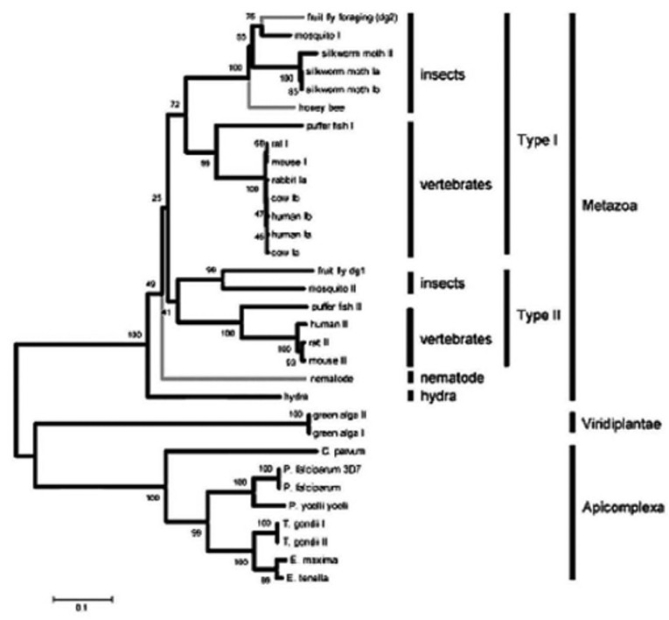Multiple Choice
Use the following information to answer the following question(s) .
The following are an abstract and figure from a paper that explores the evolutionary relationship between a protein kinase and behavior (M. Fitzpatrick and M. Sokolowski. 2004. In search of food: Exploring the evolutionary link between cGMP-dependent protein kinase (PKG) and behavior. Integrative and Comparative Biology 44:28-36) .
Abstract:
Despite an immense amount of variation in organisms throughout the animal kingdom, many of their genes show substantial conservation in DNA sequence and protein function. Here we explore the potential for a conserved evolutionary relationship between genes and their behavioral phenotypes. We investigate the evolutionary history of cGMP-dependent protein kinase (PKG) and its possible conserved function in food-related behaviors. First identified for its role in the foraging behavior of fruit flies, the PKG encoded by the foraging gene had since been associated with the maturation of behavior (from nurse to forager) in honey bees and the roaming and dwelling food-related locomotion in nematodes. These parallels encouraged us to construct protein phylogenies using 32 PKG sequences that include 19 species. Our analyses suggest five possible evolutionary histories that can explain the apparent conserved link between PKG and behavior in fruit flies, honey bees, and nematodes. Three of these raise the hypothesis that PKG influences the food-related behaviors of a wide variety of animals including vertebrates. Moreover it appears that the PKG gene was duplicated some time between the evolution of nematodes and a common ancestor of vertebrates and insects whereby current evidence suggests only the for-like PKG might be associated with food-related behavior.  These are neighbor joining trees that depict the evolutionary relationships of 32 PKG kinase domain and C-terminal amino acid sequences spanning 19 species of protozoans and metazoans. Values at the nodes represent the results of 5000 bootstrap replications. Lineages with known behavioral links with PKG are indicated by gray branches.
These are neighbor joining trees that depict the evolutionary relationships of 32 PKG kinase domain and C-terminal amino acid sequences spanning 19 species of protozoans and metazoans. Values at the nodes represent the results of 5000 bootstrap replications. Lineages with known behavioral links with PKG are indicated by gray branches.
-Look at the evolutionary relationship of protein kinases in the figure. Knowing that there is evidence that this particular protein kinase is linked to food-related behaviors in the animals studied, what conclusions can you draw?
A) PKG influences food-related behaviors in a wide variety of animals.
B) There is enormous variation in amino acid sequences between taxa.
C) There is likely a conserved evolutionary relationship between these genes and their behavioral phenotype.
D) PKG influences food-related behaviors in a wide variety of animals, and there is enormous variation in amino acid sequences between taxa.
E) PKG influences food-related behaviors in a wide variety of animals, and there is likely a conserved evolutionary relationship between these genes and their behavioral phenotype.
Correct Answer:

Verified
Correct Answer:
Verified
Q19: A pied kingfisher in its first year
Q20: Use the following information to answer the
Q21: How do altruistic behaviors arise through natural
Q22: If you ask a question about behavior
Q25: Which of the following might affect the
Q27: In Belding's ground squirrels, it is mostly
Q28: A pied kingfisher in its first year
Q29: Animal communication involves what type of sensory
Q47: Listed below are several examples of types
Q54: Feeding behavior with a high energy intake-to-expenditure